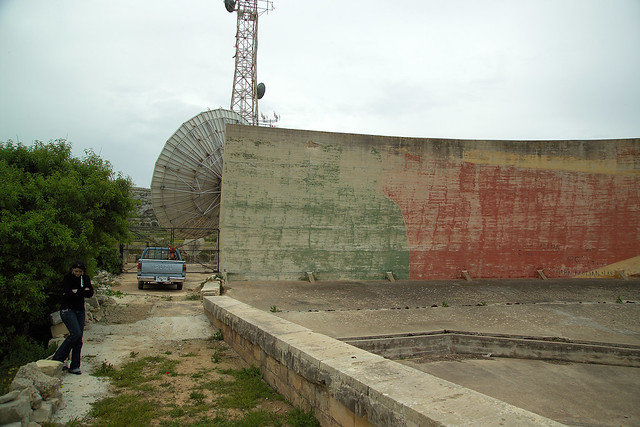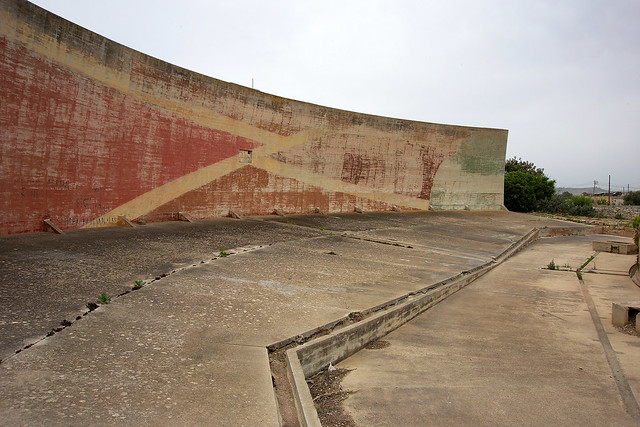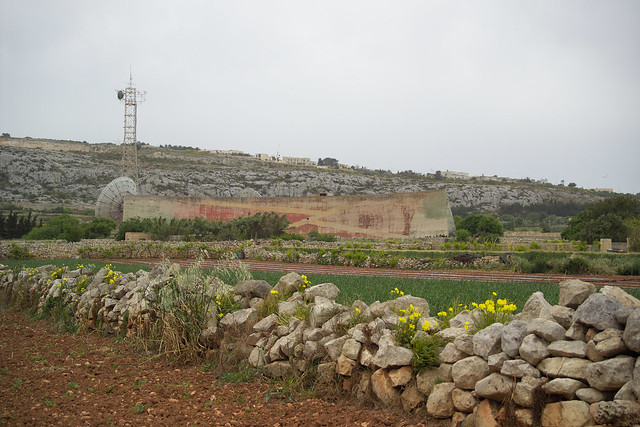In the National War Museum in Valletta, there used to be a small model of a sound locator or ‘acoustic mirror’. Constructed in the days before radar was invented, such mirrors were designed to reflect and focus the sounds of approaching aircraft so that their bearing could be calculated and an appropriate welcome organised.
The Malta mirror is known as Il Widna – the ear, and was built in a location north of the town of Naxxar. I had looked for it on various visits to Malta over the years without success, and had pretty much forgotten about it until I came across Andrew Grantham’s interesting web site. This not only provided a detailed history of the mirror, but also it’s precise location shown on a google map! The mirror stands on the site of the Maghtab earth station, used by GO Malta for their digital TV operations. I was going to be in Malta for the last weekend in April 2009 so I sent GO Malta an e-mail asking whether they would mind me photographing the site and they replied almost immediately with an offer to let me look around.
Since the first world war, British scientists had been experimenting with acoustic locators in one form or another. Early tests were made with scaled-up ear trumpets. Other fanciful proposals involved digging large arrays of pits where sentries would sit and listen for intruders. The plan was that, when an aircraft was heard, the operator would communicate the exact time of the event a central headquarters where by comparing reports from other pits, the track and speed of the aircraft could be calculated. Needless to say, further work was required to make a workable system.
By 1930 the current state of the art was the ’strip mirror’. A prototype sound locator of this design was built at Denge in the UK, followed a couple of years later by the Maltese mirror. There were plans to construct similar mirrors at strategic sites throughout the empire including five covering all approaches to Malta. As it turned out, the Maghtab mirror was the only of these concrete curiosities built in Malta. It is also the only one outside the UK. The invention of radar quickly rendered sound locators obsolete.
Il Widna is 200 feet from end to end and rises to a height of some 27 feet. In front of the wall is a sloping expanse of concrete and the ‘listening trench’ where 20 very sensitive microphones would have been located. The microphones were monitored, and their output was interpreted by operators in a small room at the back of the mirror. When the mirror was commissioned in December 1935 it had already proved to be effective in detecting incoming aircraft at a range of up to 36 miles. In other trials, 20 – 25 miles was more typical but planes were slower in those days and even from this shorter distance, would have taken a good 10 to 15 minutes to reach Malta’s coast.
When I visited the mirror I found that you could get a perfectly good view of it across the fields from the public road. It is still painted in a camouflage scheme designed to make it difficult to spot from the air but from the ground it is very easy to see. Just look for GO Malta’s satellite dishes.



